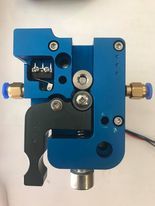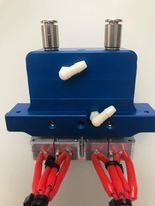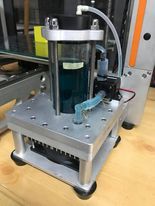Motors for duet 2 wifi
-
is your bed heavy ? what is the motor moving ? maybe you simply overloading the motor .
as others said , higher voltage will give you more torque at higher speeds . holding torque wont be effected . -
@mendelevium said in Motors for duet 2 wifi:
sl42sth40-1204a
I found the specification of those motors at https://a.allegroimg.com/s1024/0cc073/74223e8a4609b75257cfe7436eb5. As you said, the rated current is 1.2A. Their torque is quite low, so I suggest you run them at or near rated current. Try 1000mA.
You can estimate the maximum speed you can use before the motors get noisy using the motor EMF calculator that @droftarts linked to. It will be higher using 24V power than it is using 12V power.
-
@mrehorstdmd said in Motors for duet 2 wifi:
@droftarts Torque is a function of current, and current is a function of the inductance of the motor windings and supply voltage. With higher supply voltage, the current in the inductive windings rises faster than it does with lower supply voltage, so torque ramps up faster.
I knew there was a perfectly simple explanation! So the 'reservoir' analogy is kind of right. Just as well, as I think it was Dr/Prof/Sir Adrian Bowyer who told me that...
Ian
-
@mendelevium said in Motors for duet 2 wifi:
2 leadscrews connected together with a belt which IS 1.7 meters with various tensioners and guides.
Perhaps excess tension? Does the belt move easily by hand or is there a lot of resistance?
-
@Phaedrux
I wish to clarify some thing about my printer.
I have set the power to 1000. The Belts are not tight. Just tight enough.just to indicate my level of understanding on the matter, I own and run a CNC machine shop with various Vertical machining and turning centers/eroders/wire cut machines, programming and servicing for around 35 years.
This printer is one of two prototypes I designed and manufactured and spent much time with it. I wish to maybe market in the future. It is made entirely of metal,
This particular 3D printer runs reciprocating ball slides in X,Y and Z and I am prototyping running X and Y with reciprocating ball 12mm bal-lscrews. It has water cooling, twin extruders, and fully enclosed. Running it with a Duet is certainly a fitting suitable option.
The motors have to rotate faster and more with the balls-crews but certainly much stronger.
Yes the heat bed is a bit heavy as it is made from a 6mm machined frame and the bed is around 400 x 400 mm with a 3 mm borosilicate glass.
The extruders are custom made with a 1:3 reduction gearbox- spent around a year developing them.
The bottom line...
Now when I home- if I home at F100, the homing is smooth. Even movement is smooth, however on increasing the feed, like F500, there is noise and the motors vibrate... If I increase the feed like F1000, the motors will simply vibrate and whine and do not move.
I am thinking of switching to 24V and maybe go for the nema x 60mm larger motors. I can`t easily switch to an other type as it will involve extensive modifciations.
many thanks for your feedback.
Coming to ,
-
@mendelevium said in Motors for duet 2 wifi:
just to indicate my level of understanding on the matter, I own and run a CNC machine shop with various Vertical machining and turning centers/eroders/wire cut machines, programming and servicing for around 35 years.
This printer is one of two prototypes I designed and manufactured and spent much time with it. I wish to maybe market in the future. It is made entirely of metal,I'm hearing you, I have a similar background to you. I've been a toolmaker for over 30 years, designed my own printers ect. I would try the 60mm Nema 17 first since it is easier to make that swap then going to a Nema 23.
But I will say that one of my printers has a 450mm bed with twin lead screws driven by a long belt with a single motor. The bed is .250" jig plate with a PEI surface so I don't have the added weight of the glass you have. I also run 4 start threads on my lead screws which give me 8mm of travel per revolution.I put a Nema 23 motor from the start and never had and issues with high speed Z travels. I home away from the head to Z max positive so I need the high speed travels to get the table up to the printing area after homing. As I said, I never had any issues with skipped steps of the bed not moving. I also don't have to worry with bed mesh leveling, once the plate is dialed in flat (at temp) it remains flat.
You may end up going to the larger Nema 23 stepper in the long run.
-edit- Almost forgot, I run all my printers on 24V, It's better overall on motor and hotend heater performance.
-
@timcurtis67
Nice....
I have just ordered two motors from smart steppers like you mentioned and hopefully will have them by mid next week. my printer has two separate power supplies as I have a 24 V heat-bed. The Bed and extruders are controlled via solid state relays and I am thinking of putting a mains supply heat-bed. My printer I have made available the possibility to run the bed by mains power and I am mulling dedicating the 24V power supply which used to power the bed to run the duet. I am still looking for some instructions or details how to construct the heat-bed using the silicone heat-pad. I have yet found nothing but have not looked much.The reciprocating ball screws have a small pitch like 5mm. One last little bit, I played around with mechaduino and managed to get motors tuned quite well. I have also tapped out the STEP AND DIR on the Duet wifi and managed to run them (this is closed loop) however for the moment I put ordinary steppers as i wish to finalize this asap....
many thanks for your bit.
-
@timcurtis67
I love the idea of one motor driving both screws and initially my printer had two motors and the system is not fool proof. You can have one motor skip steps... -
@mendelevium Can you post your config.g, or at least the part that has the motor configuration? I think you're just trying to run the Z axis too fast for the motors, or possibly you have the microstepping set too high. Generally, you do not need to move the Z very fast; F100 is 1.6mm/s, F500 is 8.3mm/s and F1000 is 16.6mm/s, which would be extraordinarily fast for Z! However, it does sound like the existing Z motors are not strong enough for the job.
Ian
-
@mendelevium I use a ac120 volt silicon pad stuck to the bottom of my bed. It is a 750 watt heater. The heater I run is similar to this one,https://www.amazon.com/approx-KEENOVO-Universal-Flexible-Silicone/dp/B00V81ZI70.
It heats up quickly. It is powered through an SSR controlled by the duet board.
If you go that route look into adding a thermal fuse inline to one of the power wires going directly to the bed heater. That way if the SSR ever fails you won't burn you house or business down. SSR's fail in the closed position which will keep your bed heater heating up even if the duet tries to shut it off. They come in different temp settings. Once they blow you have to replace them, as they can't be reset. Good cheap insurance.It has a built in thermistor which works fine. If you drill a small hole in the side of your bed plate you can add another thermistor in the small hole and get a better overall temp reading of the bed.
Also buy a good SSR, not a cheap Chinese knockoff. I've been set up this way for several years on my large printer. It runs almost 24/7 everyday cranking out parts.
Your printers sound nice, post some pictures when you get them running.
-
@droftarts said in Motors for duet 2 wifi:
@mendelevium Can you post your config.g, or at least the part that has the motor configuration? I think you're just trying to run the Z axis too fast for the motors, or possibly you have the microstepping set too high. Generally, you do not need to move the Z very fast; F100 is 1.6mm/s, F500 is 8.3mm/s and F1000 is 16.6mm/s, which would be extraordinarily fast for Z! However, it does sound like the existing Z motors are not strong enough for the job.
Ian
On larger printers we need faster Z drives. If I home my printer to Z positive (Z +465.00) then start a print it would take over 4 minutes for the table to move up into print position at F100 (1.6mm a second). I typically move my Z at 1200-1500. Works well for Z hops too. I don't add too much time to my prints z hopping during retracts.
Or maybe I just need more patience


-
@timcurtis67 That's understandable. But you've probably got something bigger than a 1.2A NEMA 17 driving it!
Ian
-
i do not have that in hand now but will post it, however I have not been very clear..
"Now when I home- if I home at F100, the homing is smooth. Even movement is smooth, however on increasing the feed, like F500, there is noise and the motors vibrate... If I increase the feed like F1000, the motors will simply vibrate and whine and do not move."The homing feed is F100.
What I referred above is the movement of the X and Y axis...
G1 XXXX F500, there is noise and the motors vibrate... If I increase the feed like F1000, the motors will simply vibrate and whine and do not movehope I have explained myself better.
-
@timcurtis67
What did you do for the heat-bed? Aluminum plate? I am a bit concerned about the possibility of warping with the heat pad under the plate and losing the flatness... -
@mendelevium said in Motors for duet 2 wifi:
If I increase the feed like F1000, the motors will simply vibrate and whine and do not move
Two likely reasons:
-
You have set the acceleration too high in the M201 command.
-
The combination of steps/mm of your machine, motor choice and supply voltage means there is insufficient supply voltage to drive the motor that fast. However, F1000 is a low speed, so that should only be the case if either your machine has a very high steps/mm value, or the motors have high inductance. Use the EMF calculator at https://www.reprapfirmware.org/ to check.
@mendelevium said in Motors for duet 2 wifi:
This printer is one of two prototypes I designed and manufactured and spent much time with it. I wish to maybe market in the future.
Definitely change to 24V power then.
-
-
my extruders/ Water cooling/ hot end   
-
@mendelevium, unfortunately the uploads attached to your last post failed. If you are using Chrome, try uploading them from Firefox instead - that's what I do when I have this problem [frequently].
-
@mendelevium said in Motors for duet 2 wifi:
@timcurtis67
What did you do for the heat-bed? Aluminum plate? I am a bit concerned about the possibility of warping with the heat pad under the plate and losing the flatness...Here is what I use for my bed.
https://www.midweststeelsupply.com/store/castaluminumplateatp5It is very stable when heating. I do have it leveled at 70C. I usually run anywhere from 60C-70C while printing. I used the 1/4" thick plate.
-
@timcurtis67
The heat-bed plate looks great. What thickness did you manage to get. The thinnest I found was 5mm. It will be a bit heavier but with ball-screws it will be more powerful... -



Some of the gear on my 3D printers. Everything manufactured in house, including the anodizing This is the Extruder I produced x 3 reduction, the water cooled hot end the water cooler.
I will load some more pics with the ball screws